Management Accounting Report: Costing, Budgeting, and Inventory
VerifiedAdded on 2021/01/02
|15
|3716
|148
Report
AI Summary
This management accounting report delves into various aspects of financial management within an organization. It begins with an introduction to management accounting and its importance, followed by a discussion of cost classification, including fixed, variable, and semi-variable costs, along with their graphical representations and analysis. The report then explores different inventory valuation methods such as FIFO, LIFO, and the average cost method, providing detailed calculations and analyses. Performance measuring metrics, including customer experience, product quality, operational efficiency, and cost reduction, are also discussed, along with their success factors. The report further examines budgeting, defining its purposes and outlining different methods of budget preparation, including the creation of a cash budget and a budgeted income statement. Variance analysis and recommendations for cost reduction are also included, concluding with a comprehensive overview of the subject matter.

Management Accounting:
Costing and Budgeting
Costing and Budgeting
Paraphrase This Document
Need a fresh take? Get an instant paraphrase of this document with our AI Paraphraser
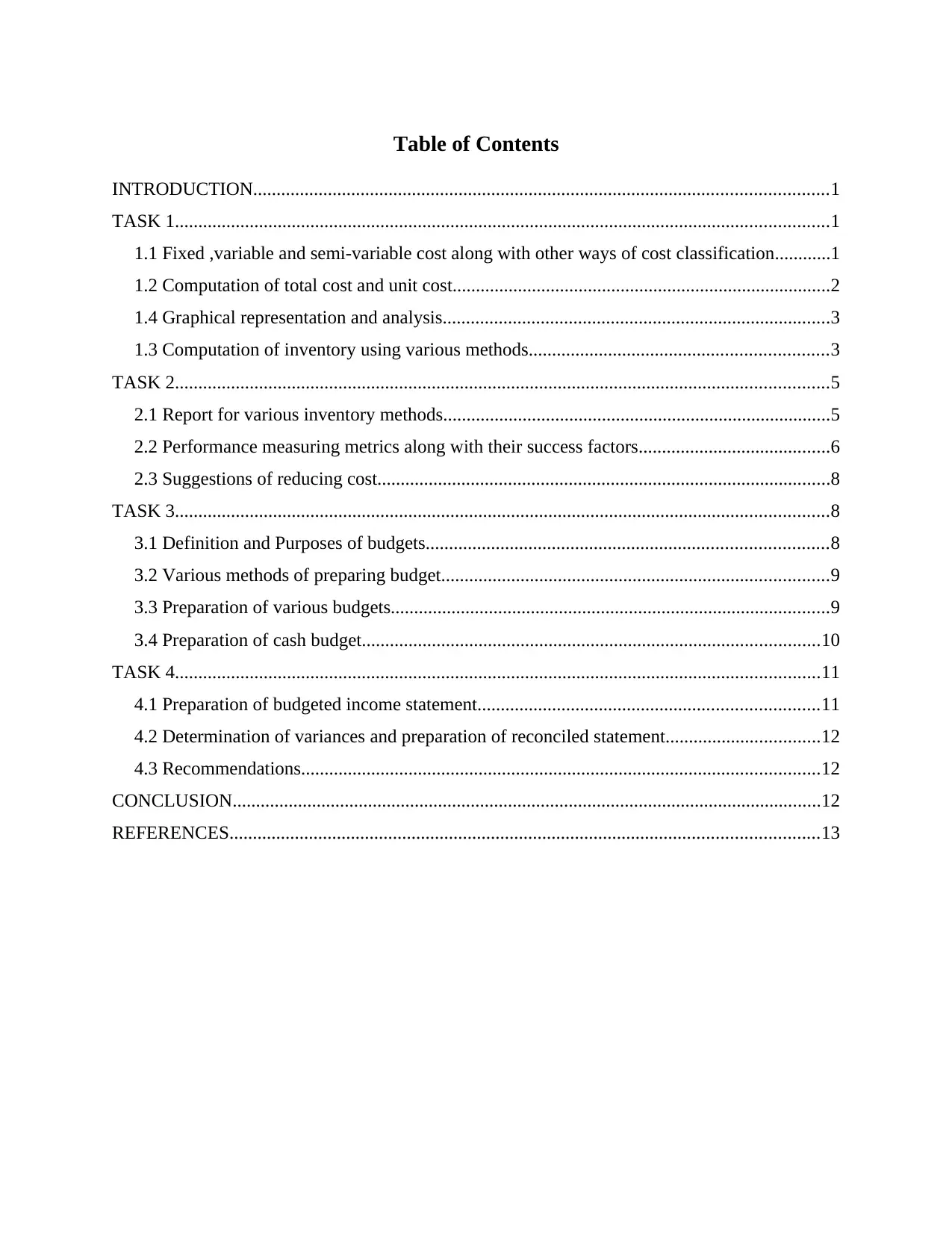
Table of Contents
INTRODUCTION...........................................................................................................................1
TASK 1............................................................................................................................................1
1.1 Fixed ,variable and semi-variable cost along with other ways of cost classification............1
1.2 Computation of total cost and unit cost.................................................................................2
1.4 Graphical representation and analysis...................................................................................3
1.3 Computation of inventory using various methods................................................................3
TASK 2............................................................................................................................................5
2.1 Report for various inventory methods...................................................................................5
2.2 Performance measuring metrics along with their success factors.........................................6
2.3 Suggestions of reducing cost.................................................................................................8
TASK 3............................................................................................................................................8
3.1 Definition and Purposes of budgets......................................................................................8
3.2 Various methods of preparing budget...................................................................................9
3.3 Preparation of various budgets..............................................................................................9
3.4 Preparation of cash budget..................................................................................................10
TASK 4..........................................................................................................................................11
4.1 Preparation of budgeted income statement.........................................................................11
4.2 Determination of variances and preparation of reconciled statement.................................12
4.3 Recommendations...............................................................................................................12
CONCLUSION..............................................................................................................................12
REFERENCES..............................................................................................................................13
INTRODUCTION...........................................................................................................................1
TASK 1............................................................................................................................................1
1.1 Fixed ,variable and semi-variable cost along with other ways of cost classification............1
1.2 Computation of total cost and unit cost.................................................................................2
1.4 Graphical representation and analysis...................................................................................3
1.3 Computation of inventory using various methods................................................................3
TASK 2............................................................................................................................................5
2.1 Report for various inventory methods...................................................................................5
2.2 Performance measuring metrics along with their success factors.........................................6
2.3 Suggestions of reducing cost.................................................................................................8
TASK 3............................................................................................................................................8
3.1 Definition and Purposes of budgets......................................................................................8
3.2 Various methods of preparing budget...................................................................................9
3.3 Preparation of various budgets..............................................................................................9
3.4 Preparation of cash budget..................................................................................................10
TASK 4..........................................................................................................................................11
4.1 Preparation of budgeted income statement.........................................................................11
4.2 Determination of variances and preparation of reconciled statement.................................12
4.3 Recommendations...............................................................................................................12
CONCLUSION..............................................................................................................................12
REFERENCES..............................................................................................................................13
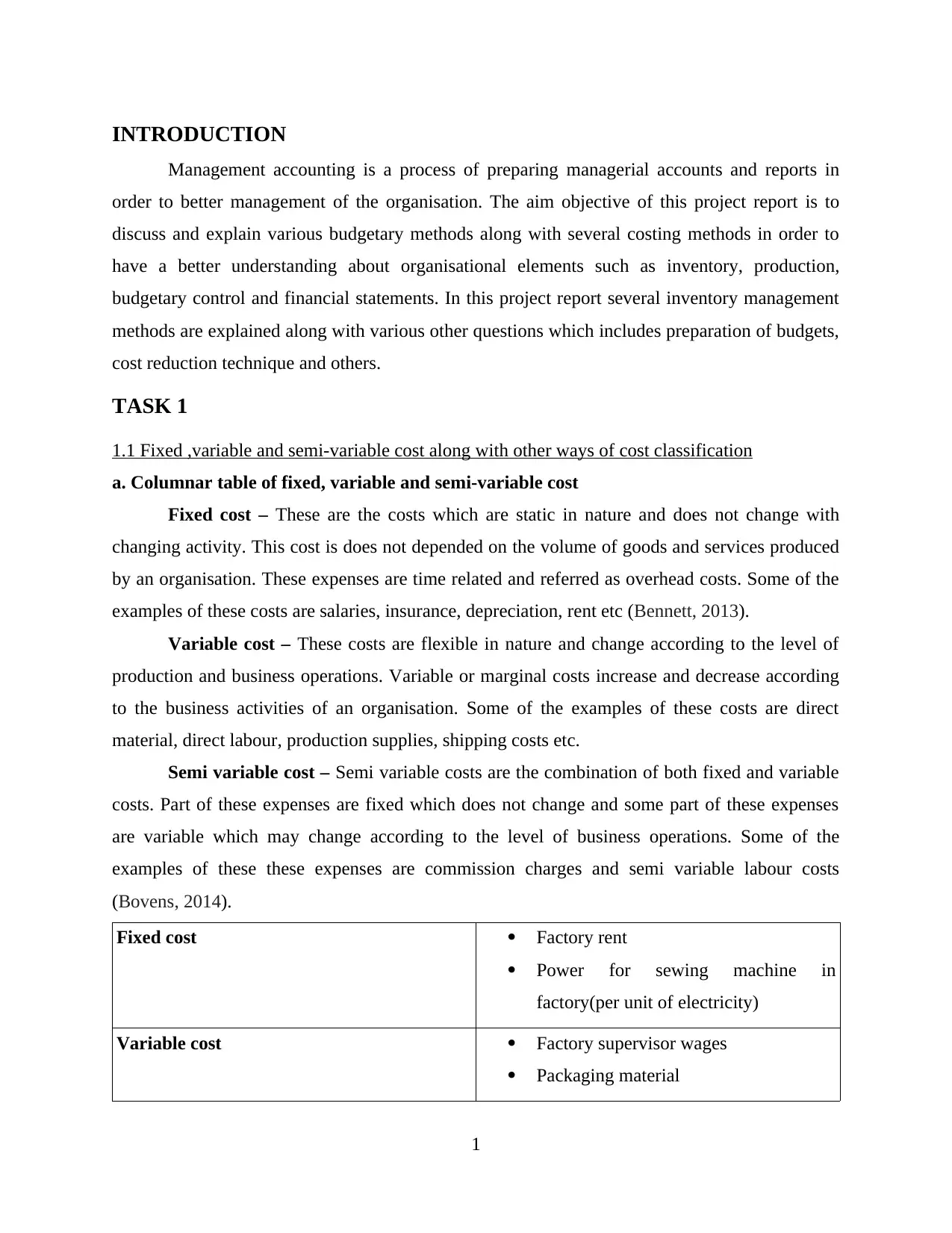
INTRODUCTION
Management accounting is a process of preparing managerial accounts and reports in
order to better management of the organisation. The aim objective of this project report is to
discuss and explain various budgetary methods along with several costing methods in order to
have a better understanding about organisational elements such as inventory, production,
budgetary control and financial statements. In this project report several inventory management
methods are explained along with various other questions which includes preparation of budgets,
cost reduction technique and others.
TASK 1
1.1 Fixed ,variable and semi-variable cost along with other ways of cost classification
a. Columnar table of fixed, variable and semi-variable cost
Fixed cost – These are the costs which are static in nature and does not change with
changing activity. This cost is does not depended on the volume of goods and services produced
by an organisation. These expenses are time related and referred as overhead costs. Some of the
examples of these costs are salaries, insurance, depreciation, rent etc (Bennett, 2013).
Variable cost – These costs are flexible in nature and change according to the level of
production and business operations. Variable or marginal costs increase and decrease according
to the business activities of an organisation. Some of the examples of these costs are direct
material, direct labour, production supplies, shipping costs etc.
Semi variable cost – Semi variable costs are the combination of both fixed and variable
costs. Part of these expenses are fixed which does not change and some part of these expenses
are variable which may change according to the level of business operations. Some of the
examples of these these expenses are commission charges and semi variable labour costs
(Bovens, 2014).
Fixed cost Factory rent
Power for sewing machine in
factory(per unit of electricity)
Variable cost Factory supervisor wages
Packaging material
1
Management accounting is a process of preparing managerial accounts and reports in
order to better management of the organisation. The aim objective of this project report is to
discuss and explain various budgetary methods along with several costing methods in order to
have a better understanding about organisational elements such as inventory, production,
budgetary control and financial statements. In this project report several inventory management
methods are explained along with various other questions which includes preparation of budgets,
cost reduction technique and others.
TASK 1
1.1 Fixed ,variable and semi-variable cost along with other ways of cost classification
a. Columnar table of fixed, variable and semi-variable cost
Fixed cost – These are the costs which are static in nature and does not change with
changing activity. This cost is does not depended on the volume of goods and services produced
by an organisation. These expenses are time related and referred as overhead costs. Some of the
examples of these costs are salaries, insurance, depreciation, rent etc (Bennett, 2013).
Variable cost – These costs are flexible in nature and change according to the level of
production and business operations. Variable or marginal costs increase and decrease according
to the business activities of an organisation. Some of the examples of these costs are direct
material, direct labour, production supplies, shipping costs etc.
Semi variable cost – Semi variable costs are the combination of both fixed and variable
costs. Part of these expenses are fixed which does not change and some part of these expenses
are variable which may change according to the level of business operations. Some of the
examples of these these expenses are commission charges and semi variable labour costs
(Bovens, 2014).
Fixed cost Factory rent
Power for sewing machine in
factory(per unit of electricity)
Variable cost Factory supervisor wages
Packaging material
1
⊘ This is a preview!⊘
Do you want full access?
Subscribe today to unlock all pages.

Trusted by 1+ million students worldwide

Office rates
Material for clothes
Semi variable cost Telephone
Factory heating
Delivery drivers pay
b. Few other ways of classification costs
Fewer other ways of classification of costs
Costs are the expenses which are needed to be paid by the organisation. These costs can
be categorized by various ways and few of them are discussed below:
By Function – Under to this classification, costs are divided according to their related
functions for which they are incurred. Broad classes included in this classification are
production, administration, selling and distribution (Chiwamit, 2014).
By Nature - Expenditures occurred in an organisation can be classified according to their
nature of activity for which they are incurred, such activities are production,
administration, selling and distribution etc.
Level of controllability – Under this, expenses are divided into two classes. First
category is of costs which can be controlled by the management like direct labour, direct
material etc. whereas another category is of uncontrollable expenses such as salaries, rent
etc.
By time – According to this classification, expenses are divided into two categories and
they are historical costs and pre determined cost. Historical costs are the expenses which
are ascertained after they are incurred in past and predetermined costs are estimated or
projected cost which are ascertained for future using trend analyses.
By normality – Costs are classified as normal costs and abnormal costs under this
classification. Normal costs are the expenses which are incurred due to normal or regular
business operations and abnormal costs are the expenses which are incurred due to
irregular business situations such as fire or theft (Edwards, 2012).
1.2 Computation of total cost and unit cost
Computation of the Total cost for the production various units
Particular Units (15000) Units (20000) Units (25000)
2
Material for clothes
Semi variable cost Telephone
Factory heating
Delivery drivers pay
b. Few other ways of classification costs
Fewer other ways of classification of costs
Costs are the expenses which are needed to be paid by the organisation. These costs can
be categorized by various ways and few of them are discussed below:
By Function – Under to this classification, costs are divided according to their related
functions for which they are incurred. Broad classes included in this classification are
production, administration, selling and distribution (Chiwamit, 2014).
By Nature - Expenditures occurred in an organisation can be classified according to their
nature of activity for which they are incurred, such activities are production,
administration, selling and distribution etc.
Level of controllability – Under this, expenses are divided into two classes. First
category is of costs which can be controlled by the management like direct labour, direct
material etc. whereas another category is of uncontrollable expenses such as salaries, rent
etc.
By time – According to this classification, expenses are divided into two categories and
they are historical costs and pre determined cost. Historical costs are the expenses which
are ascertained after they are incurred in past and predetermined costs are estimated or
projected cost which are ascertained for future using trend analyses.
By normality – Costs are classified as normal costs and abnormal costs under this
classification. Normal costs are the expenses which are incurred due to normal or regular
business operations and abnormal costs are the expenses which are incurred due to
irregular business situations such as fire or theft (Edwards, 2012).
1.2 Computation of total cost and unit cost
Computation of the Total cost for the production various units
Particular Units (15000) Units (20000) Units (25000)
2
Paraphrase This Document
Need a fresh take? Get an instant paraphrase of this document with our AI Paraphraser
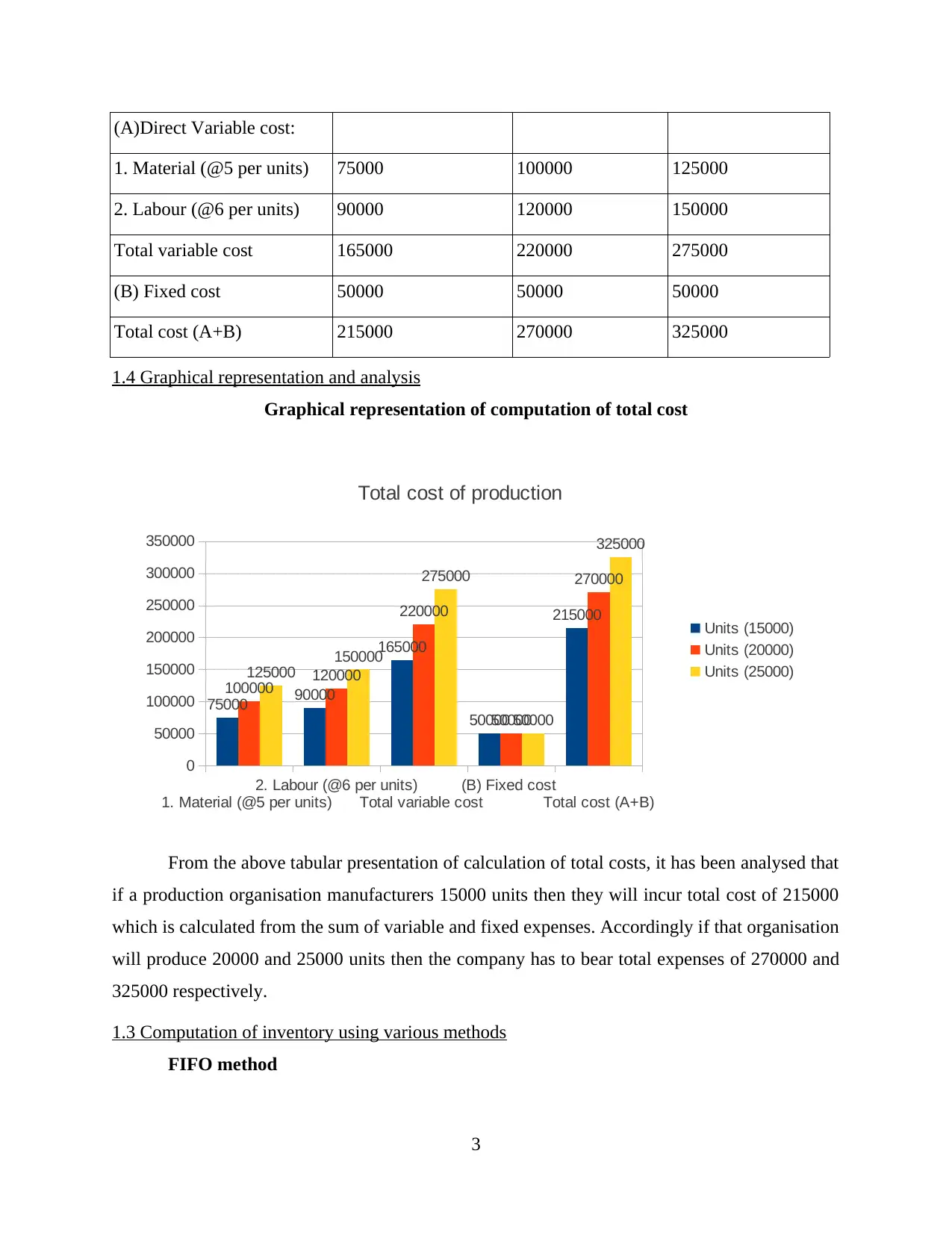
(A)Direct Variable cost:
1. Material (@5 per units) 75000 100000 125000
2. Labour (@6 per units) 90000 120000 150000
Total variable cost 165000 220000 275000
(B) Fixed cost 50000 50000 50000
Total cost (A+B) 215000 270000 325000
1.4 Graphical representation and analysis
Graphical representation of computation of total cost
1. Material (@5 per units)
2. Labour (@6 per units)
Total variable cost
(B) Fixed cost
Total cost (A+B)
0
50000
100000
150000
200000
250000
300000
350000
75000 90000
165000
50000
215000
100000 120000
220000
50000
270000
125000
150000
275000
50000
325000
Total cost of production
Units (15000)
Units (20000)
Units (25000)
From the above tabular presentation of calculation of total costs, it has been analysed that
if a production organisation manufacturers 15000 units then they will incur total cost of 215000
which is calculated from the sum of variable and fixed expenses. Accordingly if that organisation
will produce 20000 and 25000 units then the company has to bear total expenses of 270000 and
325000 respectively.
1.3 Computation of inventory using various methods
FIFO method
3
1. Material (@5 per units) 75000 100000 125000
2. Labour (@6 per units) 90000 120000 150000
Total variable cost 165000 220000 275000
(B) Fixed cost 50000 50000 50000
Total cost (A+B) 215000 270000 325000
1.4 Graphical representation and analysis
Graphical representation of computation of total cost
1. Material (@5 per units)
2. Labour (@6 per units)
Total variable cost
(B) Fixed cost
Total cost (A+B)
0
50000
100000
150000
200000
250000
300000
350000
75000 90000
165000
50000
215000
100000 120000
220000
50000
270000
125000
150000
275000
50000
325000
Total cost of production
Units (15000)
Units (20000)
Units (25000)
From the above tabular presentation of calculation of total costs, it has been analysed that
if a production organisation manufacturers 15000 units then they will incur total cost of 215000
which is calculated from the sum of variable and fixed expenses. Accordingly if that organisation
will produce 20000 and 25000 units then the company has to bear total expenses of 270000 and
325000 respectively.
1.3 Computation of inventory using various methods
FIFO method
3
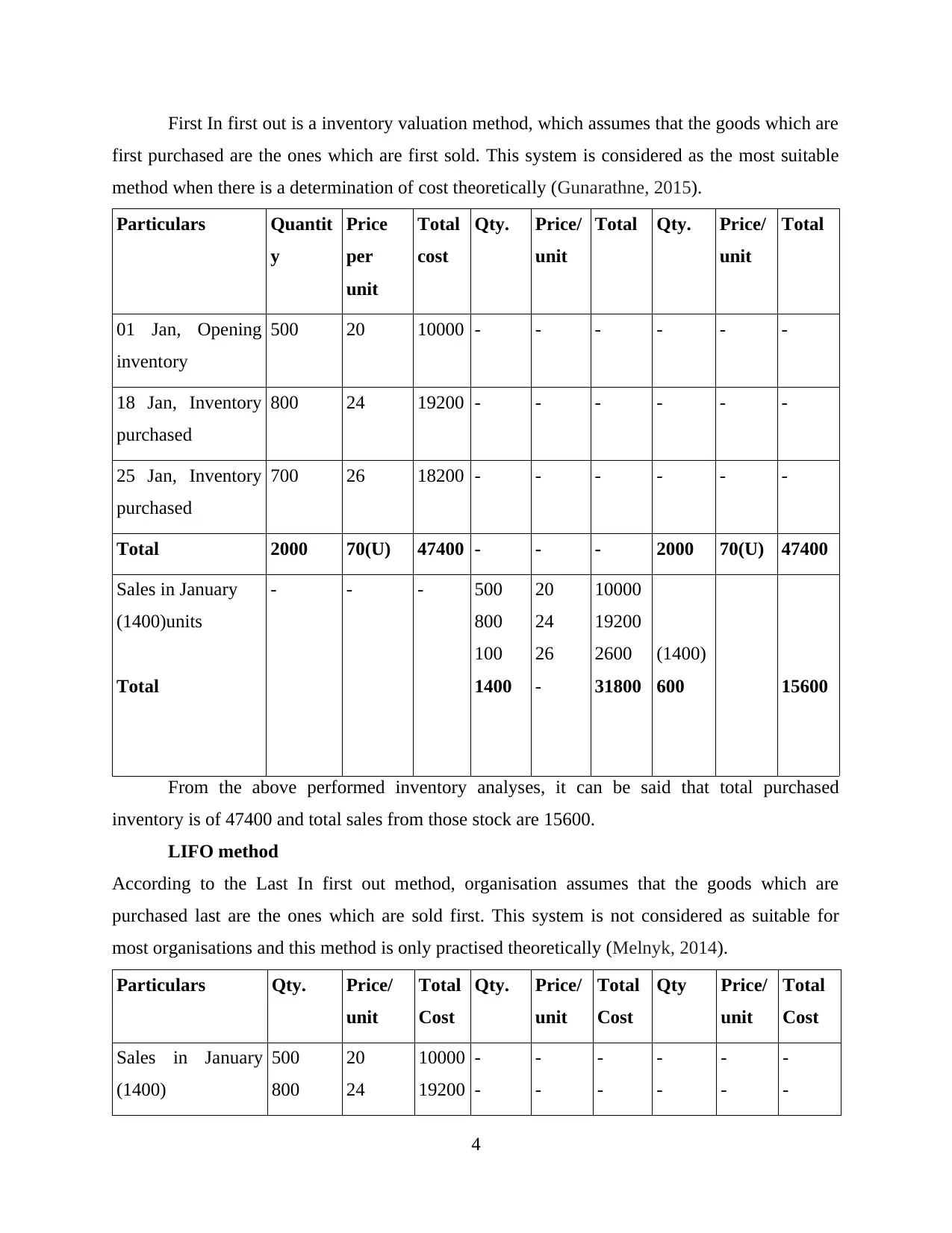
First In first out is a inventory valuation method, which assumes that the goods which are
first purchased are the ones which are first sold. This system is considered as the most suitable
method when there is a determination of cost theoretically (Gunarathne, 2015).
Particulars Quantit
y
Price
per
unit
Total
cost
Qty. Price/
unit
Total Qty. Price/
unit
Total
01 Jan, Opening
inventory
500 20 10000 - - - - - -
18 Jan, Inventory
purchased
800 24 19200 - - - - - -
25 Jan, Inventory
purchased
700 26 18200 - - - - - -
Total 2000 70(U) 47400 - - - 2000 70(U) 47400
Sales in January
(1400)units
Total
- - - 500
800
100
1400
20
24
26
-
10000
19200
2600
31800
(1400)
600 15600
From the above performed inventory analyses, it can be said that total purchased
inventory is of 47400 and total sales from those stock are 15600.
LIFO method
According to the Last In first out method, organisation assumes that the goods which are
purchased last are the ones which are sold first. This system is not considered as suitable for
most organisations and this method is only practised theoretically (Melnyk, 2014).
Particulars Qty. Price/
unit
Total
Cost
Qty. Price/
unit
Total
Cost
Qty Price/
unit
Total
Cost
Sales in January
(1400)
500
800
20
24
10000
19200
-
-
-
-
-
-
-
-
-
-
-
-
4
first purchased are the ones which are first sold. This system is considered as the most suitable
method when there is a determination of cost theoretically (Gunarathne, 2015).
Particulars Quantit
y
Price
per
unit
Total
cost
Qty. Price/
unit
Total Qty. Price/
unit
Total
01 Jan, Opening
inventory
500 20 10000 - - - - - -
18 Jan, Inventory
purchased
800 24 19200 - - - - - -
25 Jan, Inventory
purchased
700 26 18200 - - - - - -
Total 2000 70(U) 47400 - - - 2000 70(U) 47400
Sales in January
(1400)units
Total
- - - 500
800
100
1400
20
24
26
-
10000
19200
2600
31800
(1400)
600 15600
From the above performed inventory analyses, it can be said that total purchased
inventory is of 47400 and total sales from those stock are 15600.
LIFO method
According to the Last In first out method, organisation assumes that the goods which are
purchased last are the ones which are sold first. This system is not considered as suitable for
most organisations and this method is only practised theoretically (Melnyk, 2014).
Particulars Qty. Price/
unit
Total
Cost
Qty. Price/
unit
Total
Cost
Qty Price/
unit
Total
Cost
Sales in January
(1400)
500
800
20
24
10000
19200
-
-
-
-
-
-
-
-
-
-
-
-
4
⊘ This is a preview!⊘
Do you want full access?
Subscribe today to unlock all pages.

Trusted by 1+ million students worldwide
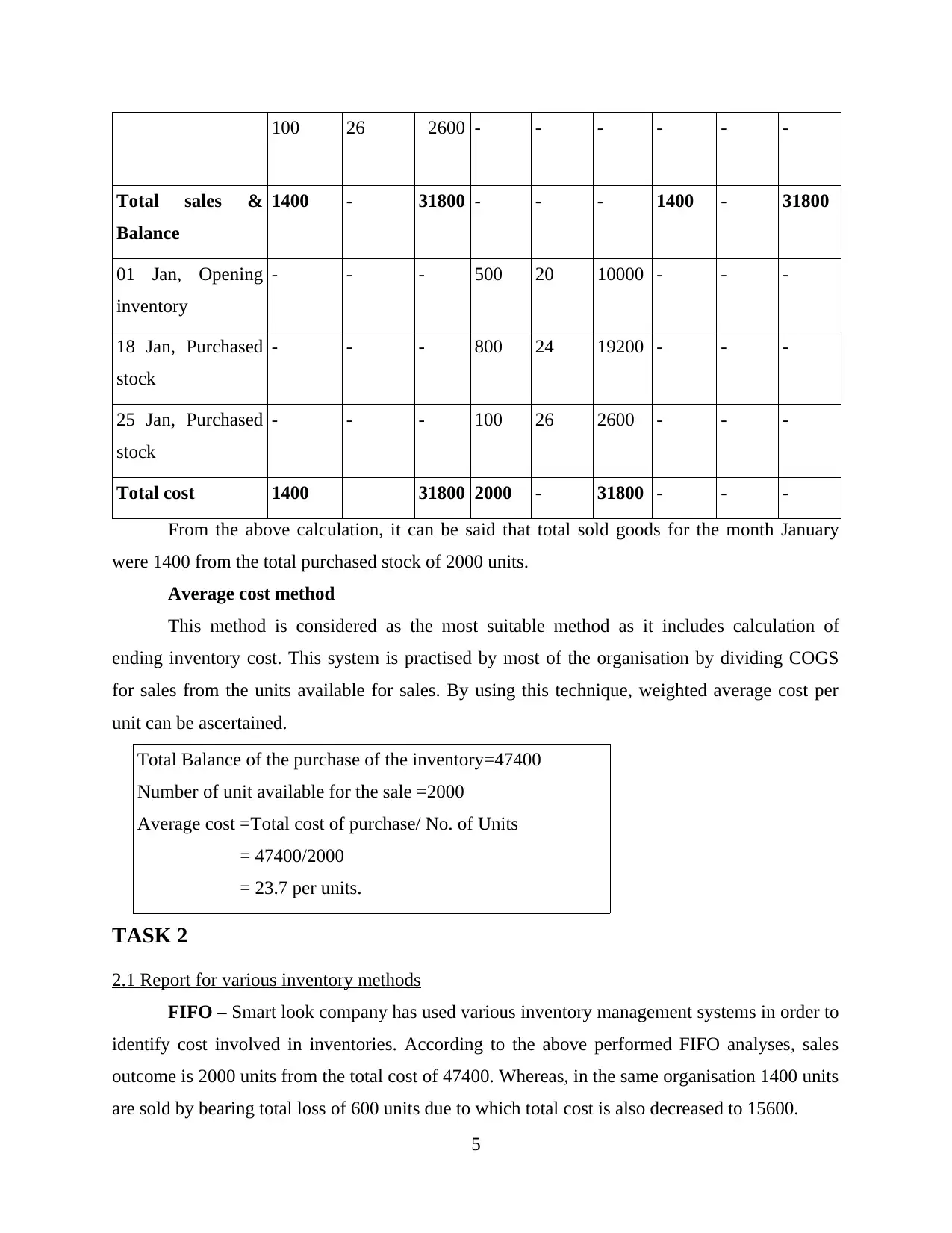
100 26 2600 - - - - - -
Total sales &
Balance
1400 - 31800 - - - 1400 - 31800
01 Jan, Opening
inventory
- - - 500 20 10000 - - -
18 Jan, Purchased
stock
- - - 800 24 19200 - - -
25 Jan, Purchased
stock
- - - 100 26 2600 - - -
Total cost 1400 31800 2000 - 31800 - - -
From the above calculation, it can be said that total sold goods for the month January
were 1400 from the total purchased stock of 2000 units.
Average cost method
This method is considered as the most suitable method as it includes calculation of
ending inventory cost. This system is practised by most of the organisation by dividing COGS
for sales from the units available for sales. By using this technique, weighted average cost per
unit can be ascertained.
Total Balance of the purchase of the inventory=47400
Number of unit available for the sale =2000
Average cost =Total cost of purchase/ No. of Units
= 47400/2000
= 23.7 per units.
TASK 2
2.1 Report for various inventory methods
FIFO – Smart look company has used various inventory management systems in order to
identify cost involved in inventories. According to the above performed FIFO analyses, sales
outcome is 2000 units from the total cost of 47400. Whereas, in the same organisation 1400 units
are sold by bearing total loss of 600 units due to which total cost is also decreased to 15600.
5
Total sales &
Balance
1400 - 31800 - - - 1400 - 31800
01 Jan, Opening
inventory
- - - 500 20 10000 - - -
18 Jan, Purchased
stock
- - - 800 24 19200 - - -
25 Jan, Purchased
stock
- - - 100 26 2600 - - -
Total cost 1400 31800 2000 - 31800 - - -
From the above calculation, it can be said that total sold goods for the month January
were 1400 from the total purchased stock of 2000 units.
Average cost method
This method is considered as the most suitable method as it includes calculation of
ending inventory cost. This system is practised by most of the organisation by dividing COGS
for sales from the units available for sales. By using this technique, weighted average cost per
unit can be ascertained.
Total Balance of the purchase of the inventory=47400
Number of unit available for the sale =2000
Average cost =Total cost of purchase/ No. of Units
= 47400/2000
= 23.7 per units.
TASK 2
2.1 Report for various inventory methods
FIFO – Smart look company has used various inventory management systems in order to
identify cost involved in inventories. According to the above performed FIFO analyses, sales
outcome is 2000 units from the total cost of 47400. Whereas, in the same organisation 1400 units
are sold by bearing total loss of 600 units due to which total cost is also decreased to 15600.
5
Paraphrase This Document
Need a fresh take? Get an instant paraphrase of this document with our AI Paraphraser

Cost of goods sold using this method is calculated below:
Opening inventory : 500*20 =10000
Add : Purchase inventory 18 Jan : 800*24=19200
purchase inventory 25 Jan :700*26 =18200
Total goods available for sale = 47400
Less : closing inventory 1400*600 = 28000
Cost of goods sold = 19400
LIFO – According to the LIFO method, the results which are obtained are complete
reverse as the units available by the organisation are 1400 for which have incurred cost of sale of
31800. No information is available for the purchased inventory of the company due to which it
has referred as nil. With the help of this analysis method, total cost available in the organisation
for the sale and purchase of inventory is calculated and evaluated. Cost of goods sold for the
inventory of January month is calculated below:
Opening inventory : 1400*20=28000
Add: purchase inventory 18 Jun : 800*24 =19200
purchase inventory 25 Jan :700*26 =18200
Total goods available for sale: = 65400
Less: Closing inventory 1400*26 : = 36400
Cost of Goods sold =29000
Average cost method – Smart looks company has used average cost method in order to
help the organisation to ascertain average cost that they have to pay for the very unit produced.
From the above calculation of average cost method, it has been observed that 23.7 per unit is to
be paid for each unit which is produced by the company. Cost of goods sold the January month
using this method is calculated below:
Opening inventory 1400*26 : = 36400
Add : purchase inventory 18 Jun : 800*24 =19200
purchase inventory 25 Jan :700*26 =18200
Total goods available for sale =73800
Less Closing stock 1400*23.7 =33180
Cost of Goods sold =40620
6
Opening inventory : 500*20 =10000
Add : Purchase inventory 18 Jan : 800*24=19200
purchase inventory 25 Jan :700*26 =18200
Total goods available for sale = 47400
Less : closing inventory 1400*600 = 28000
Cost of goods sold = 19400
LIFO – According to the LIFO method, the results which are obtained are complete
reverse as the units available by the organisation are 1400 for which have incurred cost of sale of
31800. No information is available for the purchased inventory of the company due to which it
has referred as nil. With the help of this analysis method, total cost available in the organisation
for the sale and purchase of inventory is calculated and evaluated. Cost of goods sold for the
inventory of January month is calculated below:
Opening inventory : 1400*20=28000
Add: purchase inventory 18 Jun : 800*24 =19200
purchase inventory 25 Jan :700*26 =18200
Total goods available for sale: = 65400
Less: Closing inventory 1400*26 : = 36400
Cost of Goods sold =29000
Average cost method – Smart looks company has used average cost method in order to
help the organisation to ascertain average cost that they have to pay for the very unit produced.
From the above calculation of average cost method, it has been observed that 23.7 per unit is to
be paid for each unit which is produced by the company. Cost of goods sold the January month
using this method is calculated below:
Opening inventory 1400*26 : = 36400
Add : purchase inventory 18 Jun : 800*24 =19200
purchase inventory 25 Jan :700*26 =18200
Total goods available for sale =73800
Less Closing stock 1400*23.7 =33180
Cost of Goods sold =40620
6
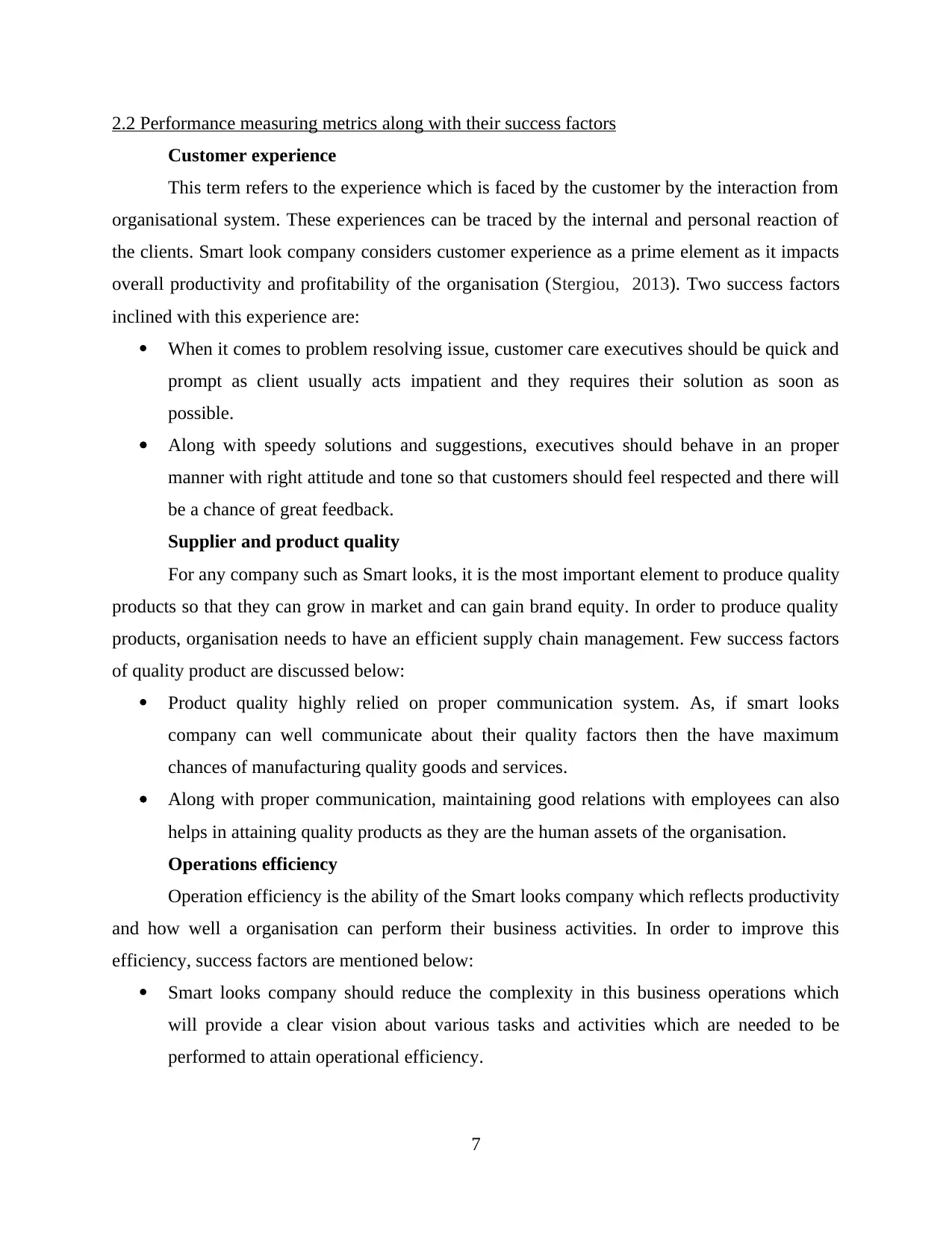
2.2 Performance measuring metrics along with their success factors
Customer experience
This term refers to the experience which is faced by the customer by the interaction from
organisational system. These experiences can be traced by the internal and personal reaction of
the clients. Smart look company considers customer experience as a prime element as it impacts
overall productivity and profitability of the organisation (Stergiou, 2013). Two success factors
inclined with this experience are:
When it comes to problem resolving issue, customer care executives should be quick and
prompt as client usually acts impatient and they requires their solution as soon as
possible.
Along with speedy solutions and suggestions, executives should behave in an proper
manner with right attitude and tone so that customers should feel respected and there will
be a chance of great feedback.
Supplier and product quality
For any company such as Smart looks, it is the most important element to produce quality
products so that they can grow in market and can gain brand equity. In order to produce quality
products, organisation needs to have an efficient supply chain management. Few success factors
of quality product are discussed below:
Product quality highly relied on proper communication system. As, if smart looks
company can well communicate about their quality factors then the have maximum
chances of manufacturing quality goods and services.
Along with proper communication, maintaining good relations with employees can also
helps in attaining quality products as they are the human assets of the organisation.
Operations efficiency
Operation efficiency is the ability of the Smart looks company which reflects productivity
and how well a organisation can perform their business activities. In order to improve this
efficiency, success factors are mentioned below:
Smart looks company should reduce the complexity in this business operations which
will provide a clear vision about various tasks and activities which are needed to be
performed to attain operational efficiency.
7
Customer experience
This term refers to the experience which is faced by the customer by the interaction from
organisational system. These experiences can be traced by the internal and personal reaction of
the clients. Smart look company considers customer experience as a prime element as it impacts
overall productivity and profitability of the organisation (Stergiou, 2013). Two success factors
inclined with this experience are:
When it comes to problem resolving issue, customer care executives should be quick and
prompt as client usually acts impatient and they requires their solution as soon as
possible.
Along with speedy solutions and suggestions, executives should behave in an proper
manner with right attitude and tone so that customers should feel respected and there will
be a chance of great feedback.
Supplier and product quality
For any company such as Smart looks, it is the most important element to produce quality
products so that they can grow in market and can gain brand equity. In order to produce quality
products, organisation needs to have an efficient supply chain management. Few success factors
of quality product are discussed below:
Product quality highly relied on proper communication system. As, if smart looks
company can well communicate about their quality factors then the have maximum
chances of manufacturing quality goods and services.
Along with proper communication, maintaining good relations with employees can also
helps in attaining quality products as they are the human assets of the organisation.
Operations efficiency
Operation efficiency is the ability of the Smart looks company which reflects productivity
and how well a organisation can perform their business activities. In order to improve this
efficiency, success factors are mentioned below:
Smart looks company should reduce the complexity in this business operations which
will provide a clear vision about various tasks and activities which are needed to be
performed to attain operational efficiency.
7
⊘ This is a preview!⊘
Do you want full access?
Subscribe today to unlock all pages.

Trusted by 1+ million students worldwide

Fixed costs such as storage cost and others must be effectively managed as the influence
growth of the company (Suomala, 2012).
Reducing maintenance spending
Smart looks company should cut down their expenses which are irrelevant or
unnecessary. Maintenance expenses highly impact an organisation as these expenses can be
decreased by proper management and controlling practices. Success factors related to
maintenance expenses are mentioned below:
Smart looks company should use computerised maintenance technology so that they can
control these expenses by using more reliable and accurate measures.
This organisation must include preventive maintenance in their operations, according to
which they should set a fixed schedule for checking of critical equipments.
Cost reduction and profitability increase
Cost included in business operations must be reduced by Smart looks company in order
to gain more profitability which will help the organisation in growth and development. Success
factor for this metric are:
In order to gain increased profitability, the above mentioned company should produce
more attractive and cost efficient products in order to attract customers.
Economy growth is also an success factor as, if the economy is growing then the demand
for luxury goods will also increase (Tucker, 2016).
2.3 Suggestions of reducing cost
In order to reduce the costs, few suggestions are mentioned below:
Smart looks company can reduce its supply expenses such as office supplies which can
be reduced by buying these goods in bulk through a specific vendor.
Production costs and financial expenses should be lowered by using updated technologies
along with using various policies such as optimum utilisation of the resources.
Value and quality can be enhanced by focusing on qualitative measures and not quantitative
measures as by producing quality products, organisation can gain trust of public which will
ultimately result in enhanced value of the company. This value can be increased using various
strategies of price constant and others (Zaleha Abdul Rasid, 2011).
8
growth of the company (Suomala, 2012).
Reducing maintenance spending
Smart looks company should cut down their expenses which are irrelevant or
unnecessary. Maintenance expenses highly impact an organisation as these expenses can be
decreased by proper management and controlling practices. Success factors related to
maintenance expenses are mentioned below:
Smart looks company should use computerised maintenance technology so that they can
control these expenses by using more reliable and accurate measures.
This organisation must include preventive maintenance in their operations, according to
which they should set a fixed schedule for checking of critical equipments.
Cost reduction and profitability increase
Cost included in business operations must be reduced by Smart looks company in order
to gain more profitability which will help the organisation in growth and development. Success
factor for this metric are:
In order to gain increased profitability, the above mentioned company should produce
more attractive and cost efficient products in order to attract customers.
Economy growth is also an success factor as, if the economy is growing then the demand
for luxury goods will also increase (Tucker, 2016).
2.3 Suggestions of reducing cost
In order to reduce the costs, few suggestions are mentioned below:
Smart looks company can reduce its supply expenses such as office supplies which can
be reduced by buying these goods in bulk through a specific vendor.
Production costs and financial expenses should be lowered by using updated technologies
along with using various policies such as optimum utilisation of the resources.
Value and quality can be enhanced by focusing on qualitative measures and not quantitative
measures as by producing quality products, organisation can gain trust of public which will
ultimately result in enhanced value of the company. This value can be increased using various
strategies of price constant and others (Zaleha Abdul Rasid, 2011).
8
Paraphrase This Document
Need a fresh take? Get an instant paraphrase of this document with our AI Paraphraser
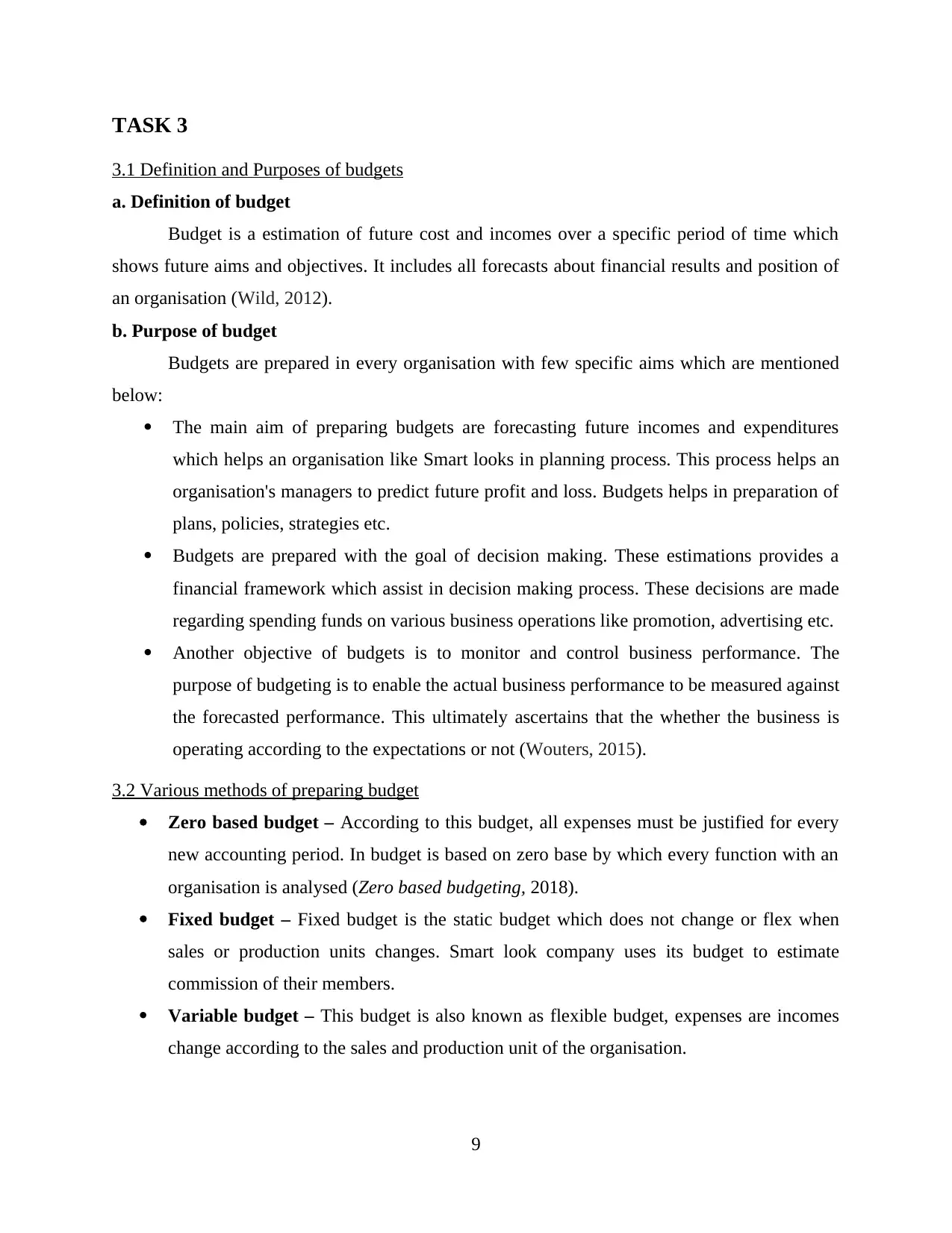
TASK 3
3.1 Definition and Purposes of budgets
a. Definition of budget
Budget is a estimation of future cost and incomes over a specific period of time which
shows future aims and objectives. It includes all forecasts about financial results and position of
an organisation (Wild, 2012).
b. Purpose of budget
Budgets are prepared in every organisation with few specific aims which are mentioned
below:
The main aim of preparing budgets are forecasting future incomes and expenditures
which helps an organisation like Smart looks in planning process. This process helps an
organisation's managers to predict future profit and loss. Budgets helps in preparation of
plans, policies, strategies etc.
Budgets are prepared with the goal of decision making. These estimations provides a
financial framework which assist in decision making process. These decisions are made
regarding spending funds on various business operations like promotion, advertising etc.
Another objective of budgets is to monitor and control business performance. The
purpose of budgeting is to enable the actual business performance to be measured against
the forecasted performance. This ultimately ascertains that the whether the business is
operating according to the expectations or not (Wouters, 2015).
3.2 Various methods of preparing budget
Zero based budget – According to this budget, all expenses must be justified for every
new accounting period. In budget is based on zero base by which every function with an
organisation is analysed (Zero based budgeting, 2018).
Fixed budget – Fixed budget is the static budget which does not change or flex when
sales or production units changes. Smart look company uses its budget to estimate
commission of their members.
Variable budget – This budget is also known as flexible budget, expenses are incomes
change according to the sales and production unit of the organisation.
9
3.1 Definition and Purposes of budgets
a. Definition of budget
Budget is a estimation of future cost and incomes over a specific period of time which
shows future aims and objectives. It includes all forecasts about financial results and position of
an organisation (Wild, 2012).
b. Purpose of budget
Budgets are prepared in every organisation with few specific aims which are mentioned
below:
The main aim of preparing budgets are forecasting future incomes and expenditures
which helps an organisation like Smart looks in planning process. This process helps an
organisation's managers to predict future profit and loss. Budgets helps in preparation of
plans, policies, strategies etc.
Budgets are prepared with the goal of decision making. These estimations provides a
financial framework which assist in decision making process. These decisions are made
regarding spending funds on various business operations like promotion, advertising etc.
Another objective of budgets is to monitor and control business performance. The
purpose of budgeting is to enable the actual business performance to be measured against
the forecasted performance. This ultimately ascertains that the whether the business is
operating according to the expectations or not (Wouters, 2015).
3.2 Various methods of preparing budget
Zero based budget – According to this budget, all expenses must be justified for every
new accounting period. In budget is based on zero base by which every function with an
organisation is analysed (Zero based budgeting, 2018).
Fixed budget – Fixed budget is the static budget which does not change or flex when
sales or production units changes. Smart look company uses its budget to estimate
commission of their members.
Variable budget – This budget is also known as flexible budget, expenses are incomes
change according to the sales and production unit of the organisation.
9
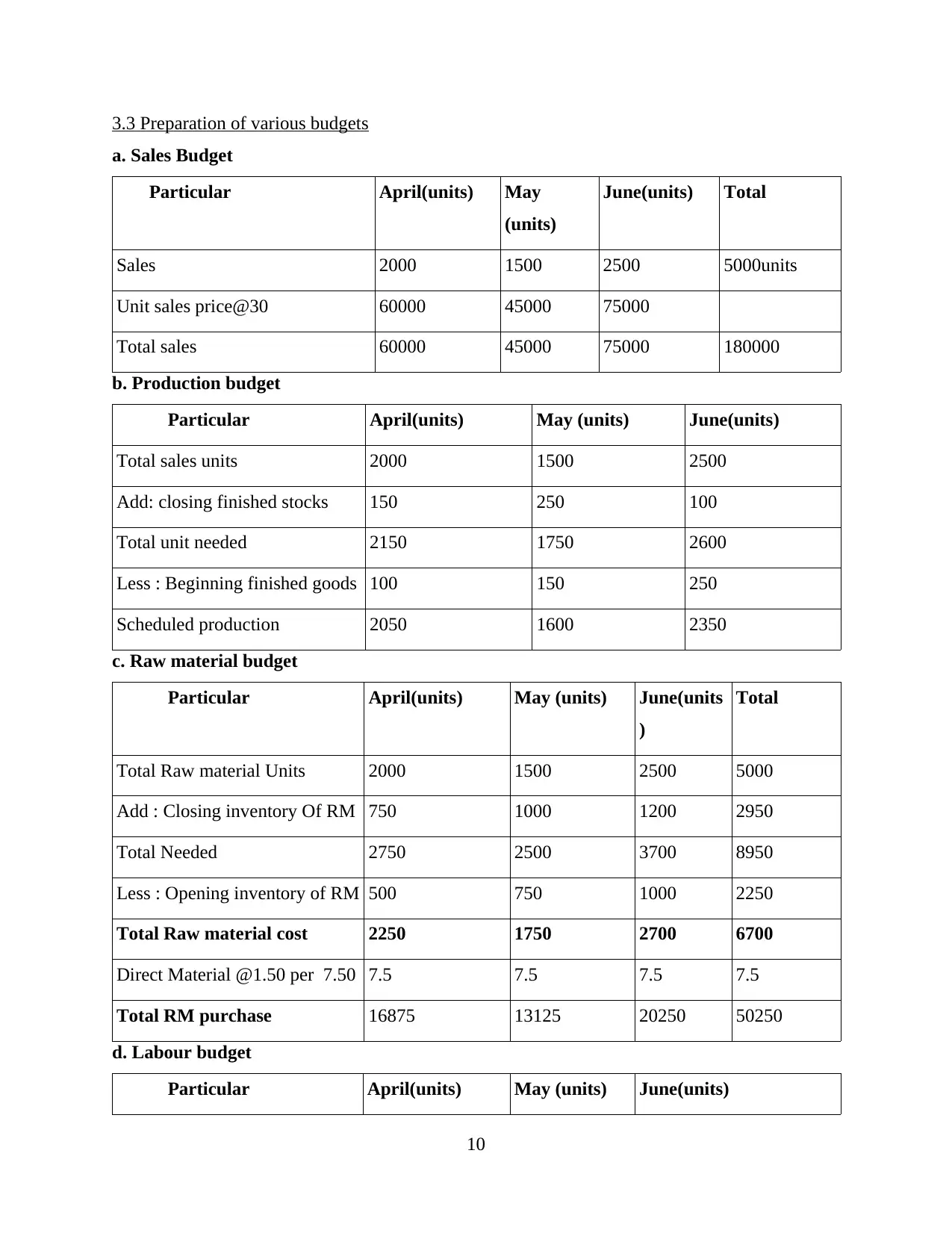
3.3 Preparation of various budgets
a. Sales Budget
Particular April(units) May
(units)
June(units) Total
Sales 2000 1500 2500 5000units
Unit sales price@30 60000 45000 75000
Total sales 60000 45000 75000 180000
b. Production budget
Particular April(units) May (units) June(units)
Total sales units 2000 1500 2500
Add: closing finished stocks 150 250 100
Total unit needed 2150 1750 2600
Less : Beginning finished goods 100 150 250
Scheduled production 2050 1600 2350
c. Raw material budget
Particular April(units) May (units) June(units
)
Total
Total Raw material Units 2000 1500 2500 5000
Add : Closing inventory Of RM 750 1000 1200 2950
Total Needed 2750 2500 3700 8950
Less : Opening inventory of RM 500 750 1000 2250
Total Raw material cost 2250 1750 2700 6700
Direct Material @1.50 per 7.50 7.5 7.5 7.5 7.5
Total RM purchase 16875 13125 20250 50250
d. Labour budget
Particular April(units) May (units) June(units)
10
a. Sales Budget
Particular April(units) May
(units)
June(units) Total
Sales 2000 1500 2500 5000units
Unit sales price@30 60000 45000 75000
Total sales 60000 45000 75000 180000
b. Production budget
Particular April(units) May (units) June(units)
Total sales units 2000 1500 2500
Add: closing finished stocks 150 250 100
Total unit needed 2150 1750 2600
Less : Beginning finished goods 100 150 250
Scheduled production 2050 1600 2350
c. Raw material budget
Particular April(units) May (units) June(units
)
Total
Total Raw material Units 2000 1500 2500 5000
Add : Closing inventory Of RM 750 1000 1200 2950
Total Needed 2750 2500 3700 8950
Less : Opening inventory of RM 500 750 1000 2250
Total Raw material cost 2250 1750 2700 6700
Direct Material @1.50 per 7.50 7.5 7.5 7.5 7.5
Total RM purchase 16875 13125 20250 50250
d. Labour budget
Particular April(units) May (units) June(units)
10
⊘ This is a preview!⊘
Do you want full access?
Subscribe today to unlock all pages.

Trusted by 1+ million students worldwide
1 out of 15
Related Documents
Your All-in-One AI-Powered Toolkit for Academic Success.
+13062052269
info@desklib.com
Available 24*7 on WhatsApp / Email
![[object Object]](/_next/static/media/star-bottom.7253800d.svg)
Unlock your academic potential
Copyright © 2020–2025 A2Z Services. All Rights Reserved. Developed and managed by ZUCOL.





